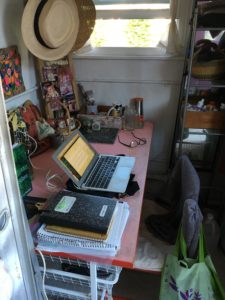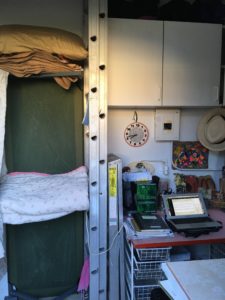My name is Jenny Nazak. I’m a self-employed writer, artist, and permaculture designer living on the Atlantic coast of Florida, in Daytona Beach. I moved here in summer 2010 from Austin, Texas, where I lived for 15 years. Before that I lived in central Tokyo for 5 years. And, I grew up in a Navy family so we moved every couple of years in my childhood. I’ve been doing the RIOT since about 2007.
My seaside Florida neighborhood is historic, and is made up of narrowish streets laid out on a grid. I’m about three short blocks from the ocean. The houses in our neighborhood are of modest size (600-1,200 square feet mostly) and on small lots. In March 2018, after having been a renter for almost all of my adult life, I bought a house, which is 988 square feet.
I’m legally a household of one, though I have seasonal and temporary roommates. (I had one young man who stayed here for the summer to work.) I’m now aspiring to get either 1) longterm RIOT roommates who truly love the lifestyle and want to build community together; and/or 2) temporary roommates who are willing to do the RIOT lifestyle at least on a trial basis because it saves a ton of money and is a great way to stay healthy and free up headspace for creative endeavors.
TRANSPORTATION
Transportation is a big challenge area for me. Day-to-day is not the issue. I can walk or cycle to 95% of my errands and events; the rest I can generally get to by bus or rideshare. For me, living in a walkable place with close-by neighbors is essential to my happiness and sense of security.
My pitfall is long-distance travel. For the past few years, I had been limiting my trips to 1-2 a year, to see family and friends. Since I always traveled by train or bus, I generally came in at around 50 to 100 gallons of gasoline, which is 10% to 20% of the US average 500 gallons.
However, this past year (2017), with my Mom’s illness and passing, and associated family matters, I ended up taking three airline trips and two solo car journeys adding up to several thousand miles. Air travel isn’t even included in the RIOT, but using calculations I found online for miles per gallon of jet travel, I computed my footprint to be nowhere near the RIOT target, but still under the US average. Maybe 70% of the US average.
FOOD
Even our farmer’s market is pretty scarce in local produce. I get 95% of my groceries from the farmer’s market but a lot of them come from far away. For example, tomatoes from Tennessee. I’m working on growing at least some of my own food, but since I’m not a great gardener, I focus more on foraging for wild edibles such as prickly pear, bidens alba, spiderwort, chickweed, and other locally plentiful “weeds.” I’ve also had luck growing sweet-potato greens, which are delicious and grow well even if the tubers don’t ever appear. Long-term, I’m planning to get at least one Tower Garden, which grows a couple dozen veggie plants in a tall tiny footprint of about 3 cubic feet.
I eat more processed food than ideal still, but most of it is freegan. (Food that’s being thrown away; food that friends/neighbors bought too much of and are giving away.) My sweet tooth has gotten better as I’ve gotten older, so my “sugar footprint” has gone down as a whole. When I crave candy, I try 1) eating fruit; and 2) walking down to the candy store where it’s sold in bulk and I can bring my own little bag to fill it with just what I plan to consume that day.
I’m omnivore but limit my meat intake, particularly beef.
Local protein aspirations:
I’ve partaken of insect potlucks, and find bugs to be quite tasty! I’m looking into finding edible bugs right around here. Alas our fattest, most plentiful grasshoppers are said to be poisonous.
A neighbor is an avid fisherman, and I traded him some used fishing equipment I found in my garage, and a used SUP board I bought for myself but never ended up using because it was too unwieldy for me to carry to the beach, for pretty much a lifetime supply of fresh fish when I want it.
WATER
I use about 15 gallons a day, most of it for toilet flushing. (For cooking and drinking and washing-up, I find it pretty easy to stay at 5 or so.) I conserve water by not flushing for a pee. My house came with a well, and it works nicely. I use it instead of city water as much as possible, so my city water consumption last month was 130 gallons for the month! I still try to track my water usage. The well is hand-pumped (I took out the electric pump and have been thrilled with the hand pump.)
My bathroom sink drains into a bucket, which I use to water the yard. I’m working on transitioning my yard to shrubs, wild plants, coastal grasses that need little or no water.
BTW it rains about 49 inches a year here, which is staggering to me, as I’ve lived in so many places with much less. It’s amazing to me how few people here collect rainwater, and also how folks limit the water-holding capacity of the soil by scalping the grass and other vegetation. Not me. I collect some rainwater in barrels, and also make little trenches etc as well as adding mulch to increase the water-holding capacity of the ground at my place.
ELECTRICITY
I find it pretty easy, when living solo, to keep my electricity at 7 to 10 percent of the US average. Last month I used 70kWh; the month before was 65. If not for the fridge, about the only electric I’d need would be for laptop computer, cellphone, and internet, plus the bit of lighting I use. Having walls painted a light color, which my past several places have been, makes it pretty easy to do with only a modest amount of artificial lighting even at night. (Oh, and it helps that the streetlights are rather bright. One DOWNSIDE of urbanish living. I would rather not have streetlights — would love it if we had a “Dark Skies Ordinance” as some cities do — but I make lemonade from lemons by utilizing the streetlight for reading and writing.)
Space cooling: I just do without a/c. Yeah it gets hot here, and sleeping has its challenges, but for the most part my body is well-acclimated to heat. And I do find that I can almost always be cool, even get a bit chilly even in the dead of summer, by sleeping outdoors, either on the beach or in my yard.
Space heating: I don’t use heat. We get maybe a few nights a year under freezing. Quilts are more than adequate. And during the day, for the few cold days, getting up and briskly moving around works wonders. As do sweaters.
NATURAL GAS, HOME HEATING OIL
I use zero of either of these. I do use about a quart or two of lamp-oil a year, for my Dietz lantern.
INSULATION/AIR SEALING
I have no idea. This house has a bit of insulation in the attic but otherwise I don’t know. It’s made of block and has a conventional asphalt-shingled roof. The roof is new and I chose a very light color because, FLORIDA!
WATER HEATING
The water heater in this house is electric. I don’t use it. I haven’t used a water heater in I can’t remember how long. I’m able to heat the water I need in a kettle.
My “bath” is the ocean, plus a little fresh water from the watering-can and washcloth to wash any excess salt/sand after I get home from the beach. I feel super clean from the salt water. Back in Austin, my “bath” was Barton Springs. 68 degrees year-round!
COOKING
Similar to Debi: electric stove, solar ovens (which work fine year-round here). I also do haybox cooking (retained-heat cooking), which is boiling for a short time on the stove and then putting the pot in an insulated bag or cooler and the food finishes cooking by itself.
In the summer I eat a lot of raw veggies, fruits, smoothies. I can go days without using any fossil fuel for cooking. I do plan to make a Rocket Stove, have had them at previous places where I lived. They let you cook a meal with a handful of deadwood twigs.
CONSUMER GOODS
I mostly just don’t want stuff, so it’s easy to keep this category down, except this year was a spike because I had to get a new roof for my house. That was about $7,000, which still puts me at under the US average.
HOUSEHOLD WASTE
I generate about a pound or two of trash per week. Most of the weight savings is from composting. I also recycle, of course. BUT, since we don’t know for sure where recycling ends up, I strive to minimize my purchase of plastic containers and others that need recycling. One of my challenges is beer. I drink 2 to 4 cans a week. I’m looking into getting a refillable “Growler” from my local brewpub.
What’s important to note, is that my approach to doing the RIOT feels fun and natural and stripped-down in a good way, as in liberating, rather than feeling like deprivation (as some mainstream folks might imagine, if they just read about my practices without knowing me).
That’s all for the moment! By the way, I have a blog www.jennynazak.com where I set out to encourage other people to join the RIOT and live lighter. My latest post has photos of my “virtual tiny house” which I have just created within my house! Basically I turned my 7 x 8 foot studio/office (which used to be a laundry room til I got rid of the washer/dryer because I prefer to wash by hand and line-dry) into my whole living quarters. I did this the other day, because I realized I was nostalgic for the feeling of living in an RV or “roomette”. You can read about it here http://www.jennynazak.com/2018/11/07/midterm-elections-and-creative-living/
Cheers everyone! I’m so excited about the use of the written word as a medium. Low-bandwidth, high-efficiency transmission for all! Feel free to write me and introduce yourself. And if you need any advice or encouragement, just ask! That’s what I’m here for.
jenny


